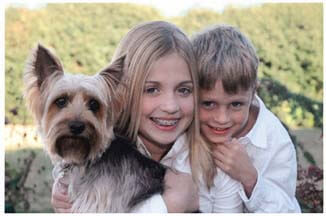
“The little dog that fits into our hearts and homes, no matter how large the former nor how small the latter, none fit better of all the breeds than the Australian Silky Terrier.” Frank Longmore, Australian All-Breed judge
The Silky Terrier is a 10 lb. silky-coated dog. He is friendly, but forceful as only a terrier can be. He is agile and light-footed and looks out on the world with a curious air that would seem to denote a degree of intelligence seldom encountered in a dog so small. A toy designed no doubt as a pet, still he has done his share of worthwhile work, for it is said that he has helped to control rodents on many an Australian poultry farm. (1)
What’s the difference between a Silky and his more popular cousin, the Yorkshire Terrier?
Ash, a dog writer from the 1800’s, mentioned “bonnie wee Skyes with long silky hair.” It can be postulated that at that time enterprising Skye breeders produced a miniature and soft-coated version of their breed. Denied recognition by the parent club, they created the now-extinct Clydesdales, which looked like blue and tan miniature Skye Terrier.
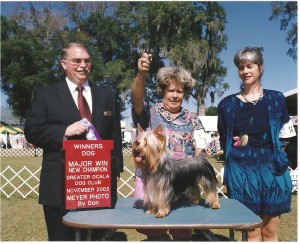
In the 1840s and ’50s, the northern English pub owners latched on to these “mini Skyes”. They needed small scrappy terriers for their rat pits (where dogs would be thrown into a pit full of rats and bets laid as to how fast they could kill). The smaller the dog, the greater the betting. These small but tough dogs were bred together with another extinct breed, the grizzled, rough-coated Waterside Terrier and the old-time Scotch Terrier, to produce the blue, tan, and fawn of the Silky Terrier and the blue and tan coloring of the Yorkshire we see today.
The father of the Yorkshire Terrier is Huddersfield Ben, seen here below in about 1865.
The Yorkshire then developed from Ben, but what about the Silky? Below is our Tessier Tagalong Heir Apparent, better known as “Albert”. Interesting comparison.
Also interesting is that Ben’s grand-dam, Katie immigrated with her owners to Australia, where the Silky Terrier (also known as the Australian Silky Terrier) was developed.
The facts as we know them are these. Yorkshire Terriers and Silky Terriers are genetically just about the same.
But the Yorkie developed in an industrialized society — northern England — where small size and long flowing coats were prized. Silkys were also developed as companion dogs, but their owners, in Australia, were pioneers who prized the Silkys’ joy of life, independent thinking, and scrappy, terrier qualities, resulting in a somewhat larger and tougher breed.
But — What’s a Silky’s Temperament??
Silkys, as mentioned above, are first and foremost a terrier. They are very loyal and love their people. But they can be dog aggressive, especially to dogs they don’t know. Some Silkys do okay at dog parks, but most don’t. In general, young Silky Terriers and very young children do not mix well. Silky puppies are small enough to be easily damaged physically or mentally by even a well-meaning small child. But a sweet Silky adult can be fine. One incredibly long-suffering Silky boy was even willing to be dressed up and put in his adored four-year-old’s baby doll’s carriage. Silkys can make a wonderful companion for an older child, as they are always ready for an adventure.
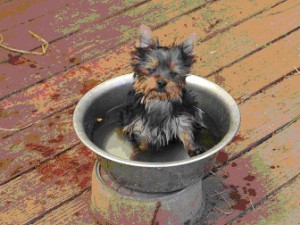
Are Silkys yappy? While I have met the occasional dog that considers barking a recreational activity, Silkys will usually bark only for a reason and are good watchdogs. In general, Silkys have a high activity level. My Rocket visited my sister once for a week. Her husband was a bit concerned that Rocket would be bouncing off the walls. Rocket could certainly be enthusiastic, especially when greeting someone, but soon plopped down in the middle of the room, back legs straight out behind him, alertly watching his people for the next game to play.
Because of their high activity level, Silkys do best with their own enclosed backyard to run off steam and chase rabbits, lizards, or squirrels. They can live in an apartment, but one needs to be prepared for lots of walks.
To get more information about Silky Terriers, or if you are interested in a puppy or a young adult, you can contact me (Sandy) best via email at sandy@smesmer.com.
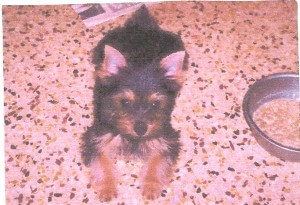

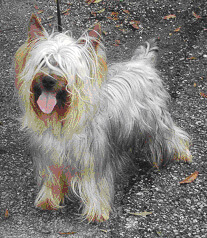
Leave a Reply